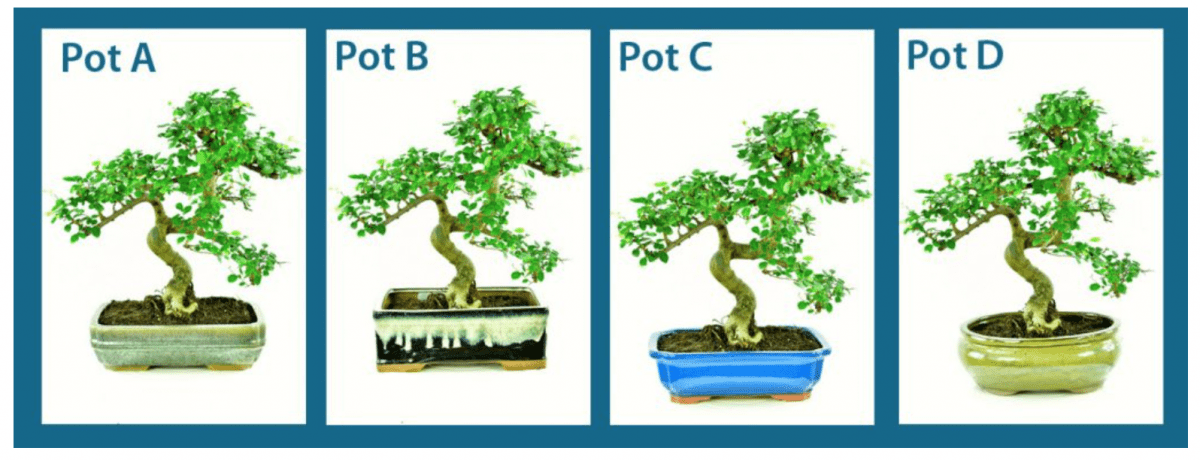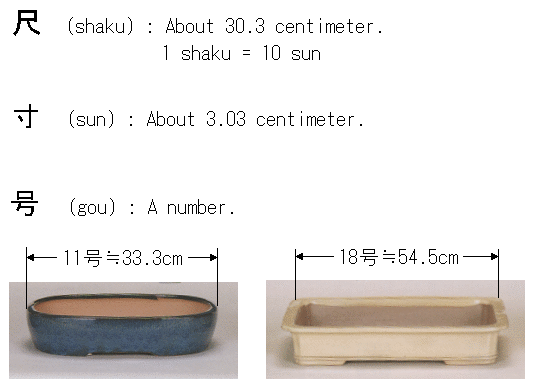The ideal pot size for bonsai is typically shallow and proportional to the tree’s size. It should allow for proper root growth and drainage.
Bonsai trees require specific pot sizes to thrive. A shallow pot is essential to control root growth and mimic natural growing conditions. Proper drainage is crucial to prevent waterlogging, which can harm the roots. Choosing the right pot size ensures the tree remains healthy and visually appealing.
The pot should complement the tree’s size and style, enhancing its overall aesthetic. Regularly checking and adjusting the pot size as the bonsai grows is vital. This careful attention helps maintain the delicate balance needed for a thriving bonsai tree.
Choosing The Right Pot Size
Choosing the right pot size for your bonsai is crucial. It affects the tree’s growth, health, and aesthetics. Here we will discuss the importance of pot size and key factors to consider.
Importance Of Pot Size
The size of the pot impacts the tree’s roots and growth. A pot that’s too small restricts root growth. This can lead to poor health and weak branches. A pot that’s too large can hold too much water. This can cause root rot and other issues.
A well-sized pot provides balance. It allows the roots to spread and grow. It helps the tree stay healthy and strong. The right pot size also enhances the tree’s beauty. It complements the tree’s shape and style.
Factors To Consider
Consider the following factors when choosing a pot size:
- Tree Size: The pot should fit the tree’s height and width.
- Root System: The pot must accommodate the root ball.
- Growth Rate: Fast-growing trees need larger pots.
- Style of Bonsai: Some styles need specific pot shapes and sizes.
- Drainage: Ensure the pot has enough drainage holes.
| Tree Height | Recommended Pot Size |
|---|---|
| Up to 6 inches | 3-4 inches |
| 6 to 12 inches | 4-6 inches |
| 12 to 18 inches | 6-8 inches |
| 18 to 24 inches | 8-10 inches |
Always match the pot size to the tree’s needs. A well-chosen pot will help your bonsai thrive.
Impact On Growth
The pot size for bonsai trees significantly impacts their growth. A well-chosen pot can enhance growth, while a poorly chosen one can hinder it. Here we will explore how pot size affects root development and nutrient absorption.
Root Development
The size of the pot influences root development. A small pot restricts root growth, making the roots compact. This compactness can lead to a healthier root system, but it also limits the tree’s ability to grow taller. On the other hand, a larger pot allows the roots to expand freely. This can lead to a robust root system, but the tree might grow taller, which may not be desired for bonsai.
| Pot Size | Root Development |
|---|---|
| Small | Compact roots, limited tree height |
| Large | Expansive roots, potentially taller tree |
Nutrient Absorption
Pot size also affects nutrient absorption. In a small pot, the soil can become nutrient-deficient more quickly. This means you need to fertilize more often to keep the tree healthy. A larger pot, on the other hand, holds more soil and therefore more nutrients. This can lead to better nutrient absorption but requires careful monitoring of water levels to avoid overwatering.
- Small Pot: Frequent fertilization, risk of nutrient deficiency.
- Large Pot: Better nutrient retention, careful water management needed.
Aesthetic Considerations
Choosing the right pot size for your bonsai is crucial for its health and beauty. Aesthetic considerations play a significant role in this decision. The pot should complement the tree, enhancing its visual impact.
Balance And Proportion
Balance and proportion are key in bonsai art. The pot should not overpower the tree. It must be in harmony with the tree’s size and style.
A small tree in a large pot looks lost and unbalanced. A large tree in a small pot appears cramped. Aim for a pot that balances the tree’s height and width.
| Tree Size | Recommended Pot Size |
|---|---|
| Small Bonsai (up to 10 inches) | 4-6 inches in width |
| Medium Bonsai (10-18 inches) | 6-10 inches in width |
| Large Bonsai (18-36 inches) | 10-18 inches in width |
Enhancing Visual Appeal
The pot’s color and shape should enhance the tree’s beauty. Neutral colors like brown, gray, or green are common. They do not distract from the tree.
The shape of the pot also matters. Rectangular pots suit formal, upright trees. Oval or round pots suit informal, cascading styles.
- Rectangular Pots: Ideal for formal styles.
- Oval Pots: Great for informal styles.
- Round Pots: Suit cascading or semi-cascading styles.
The pot’s depth should match the tree’s root system. Shallow pots are good for trees with shallow roots. Deeper pots are needed for trees with deeper roots.

Credit: www.bonsaidirect.co.uk
Types Of Pots
Choosing the right pot is essential for your bonsai’s health and appearance. There are various types of pots available. Each type has its unique features and benefits.
Traditional Pots
Traditional pots are often made from ceramic or clay. These materials offer excellent durability and breathability. They are perfect for keeping your bonsai healthy.
Traditional pots usually have a simple, elegant design. They often come in natural colors like brown, beige, and terracotta. These colors blend well with the plant and soil.
| Material | Advantages | Disadvantages |
|---|---|---|
| Clay | Breathable, Durable | Heavy, Can Break Easily |
| Ceramic | Attractive, Variety of Colors | Expensive, Fragile |
Modern Designs
Modern designs offer sleek and innovative looks. These pots can be made from various materials like plastic, fiberglass, and metal. They are often lightweight and durable.
Modern pots come in various shapes and sizes. They offer a range of colors and finishes. Some even have self-watering features. These features make them highly functional.
- Plastic: Lightweight, Affordable, Durable
- Fiberglass: Strong, Variety of Colors
- Metal: Sleek, Modern Look, Durable
Modern pots are perfect for urban spaces. They fit well in contemporary home decor. These pots can enhance the overall look of your bonsai.
Material Choices
Choosing the right material for your bonsai pot is crucial. The material affects both aesthetics and plant health. Let’s explore some popular material choices for bonsai pots.
Ceramic Pots
Ceramic pots are a popular choice for bonsai enthusiasts. They are durable and come in various designs. These pots help regulate soil moisture effectively. Ceramic pots can also withstand extreme weather conditions. This ensures a stable environment for your bonsai.
Here are some benefits of ceramic pots:
- Excellent moisture retention
- Durable and long-lasting
- Available in various styles and colors
However, ceramic pots can be heavy. This might make them harder to move. Also, they can be expensive compared to other materials.
Plastic Containers
Plastic containers are another option for bonsai enthusiasts. These containers are lightweight and easy to handle. They are also more affordable than ceramic pots. Plastic containers come in various shapes and sizes.
Below are some advantages of plastic containers:
- Lightweight and portable
- Cost-effective
- Available in various shapes and sizes
On the downside, plastic containers may not be as durable. They can also affect the aesthetics of your bonsai display.
Here’s a quick comparison of ceramic pots and plastic containers:
| Feature | Ceramic Pots | Plastic Containers |
|---|---|---|
| Durability | High | Medium |
| Moisture Retention | Excellent | Good |
| Weight | Heavy | Light |
| Cost | Expensive | Affordable |
Seasonal Changes
Bonsai trees change with the seasons. Their pot size must adapt. This ensures they thrive throughout the year.
Repotting For Growth
Repotting your bonsai tree is crucial for its growth. Trees need more space as they grow. Spring is the best time for repotting. New roots form during this season.
Follow these steps to repot your bonsai:
- Remove the tree from its old pot.
- Trim the roots carefully.
- Choose a slightly larger pot.
- Place the tree in the new pot.
- Fill with fresh soil.
Adjusting For Weather
Weather changes affect your bonsai tree. You must adjust the pot size to match these changes. Summer and winter need special attention.
Summer:
- Use a pot with good drainage.
- Ensure the pot is not too small.
- Water the tree more often.
Winter:
- Choose a pot that can handle cold temperatures.
- Ensure the pot is well-insulated.
- Reduce watering frequency.
A table may help you understand the best pot sizes for each season:
| Season | Pot Size | Special Considerations |
|---|---|---|
| Spring | Slightly larger | Repot for growth |
| Summer | Good drainage | Water more often |
| Winter | Well-insulated | Reduce watering |
Common Mistakes
Caring for a bonsai requires attention to detail, especially with pot size. Using the wrong pot can harm your tree. Here are common mistakes to avoid.
Overpotting Issues
Overpotting happens when the pot is too big for the bonsai. This can cause several problems:
- Excess Water Retention: Large pots hold too much water.
- Root Rot: Too much water can rot the roots.
- Slow Growth: The tree may grow slower.
To avoid overpotting, use a pot just big enough for the root ball. This helps the roots get enough air and water.
Underpotting Consequences
Underpotting is when the pot is too small for the bonsai. This can also cause issues:
- Root Bound: Roots get tangled and stressed.
- Limited Nutrients: Small pots hold fewer nutrients.
- Water Stress: The tree may not get enough water.
To prevent underpotting, repot the bonsai as it grows. Choose a pot that allows room for root expansion.

Credit: adamaskwhy.com
Expert Tips
Bonsai trees require special care, including the right pot size. Expert tips can guide you in selecting the perfect pot and maintaining a healthy bonsai. Read on for actionable advice.
Selecting The Perfect Pot
Choosing the right pot is crucial for bonsai health. The pot should balance aesthetics and functionality.
- Size: The pot should be slightly larger than the root ball.
- Shape: Match the pot shape with the tree style. Rectangular pots suit formal trees. Oval pots fit informal styles.
- Depth: Shallow pots are ideal for bonsai. Deep pots encourage root growth.
Ensure the pot has drainage holes. Good drainage prevents root rot.
Maintaining Healthy Bonsai
Proper pot size aids in maintaining bonsai health. Follow these tips:
- Repotting: Repot every 2-3 years. This prevents root-bound issues.
- Soil: Use well-draining soil. It retains moisture but drains excess water.
- Watering: Water the bonsai regularly. Avoid waterlogging.
Regular checks ensure your bonsai stays healthy and vibrant.
| Aspect | Recommendation |
|---|---|
| Pot Size | Slightly larger than root ball |
| Shape | Match tree style |
| Depth | Shallow |
| Drainage | Good drainage holes |
By following these tips, you can ensure your bonsai thrives.

Credit: www.tokoname.or.jp
Conclusion
Choosing the right pot size for your bonsai is crucial for its health and growth. A well-suited pot ensures proper root development. Remember to balance aesthetics and functionality. Regularly check if your bonsai needs repotting. Happy gardening and may your bonsai thrive beautifully!

